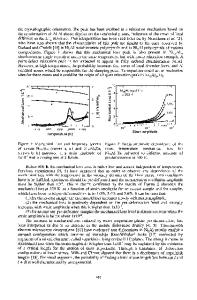The location of tantalum atoms in Ni 3 (Al, Ta)
- PDF / 566,314 Bytes
- 6 Pages / 593.28 x 841.68 pts Page_size
- 65 Downloads / 362 Views
I. INTRODUCTION
Ni3Al shows a large solubility for many ternary elements, and furthermore, the amount of strengthening produced by a given ternary addition depends upon the substitutional nature of the addition1: those which substitute for Al atoms appear to have a much larger strengthening effect than those which substitute for Ni. For example, Hf and Ta additions within the solubility range can double the yield strength of Ni3Al over a large temperature range.2 The nature of the substitutional site is therefore an important variable in any study of solid solution strengthening of Ni3Al. If it is assumed that the deficiency in Ni and/or Al content is compensated by the ternary element in order to maintain the stoichiometry of the alloy, the substitutional behavior of different ternary elements in Ni3Al can be determined simply by the direction of the gamma prime phase lobe of the corresponding ternary phase diagram.3 Results from Mossbauer spectroscopy indicate that the locations of Co and Fe in Ni3Al are in agreement with the phase diagrams,4 but due to the limited number of elements with suitable isotopes, only a few elements can be studied by this technique. Recently, several other microscopic techniques have been employed to study the sites occupied by ternary elements in Ni3Al. Conflicting results obtained using atom probe field ion microscopy (AP/FIM),5 zone-axis electron channeling microanalysis (ALCHEMI),6'7 ion channeling,8'9 and perturbed angular correlation (PAC)10 techniques have been reported. Considering first Co, an element predicted by the ternary phase diagram to favor nickel sites, results from the AP/FIM5 and the zoneaxis ALCHEMI6'7 agree with the phase diagram, but no results are available from ion channeling or PAC J. Mater. Res., Vol. 5, No. 4, Apr 1990
http://journals.cambridge.org
Downloaded: 13 Mar 2015
experiments. As for those elements predicted by the ternary phase diagrams to favor aluminum sites, e.g., Hf and Ta (which are strong solid solution strengtheners and are also neighbors in the periodic table), the results from the AP/FIM5 and the zone-axis ALCHEMI6'7 experiments agree with the phase diagrams, but the conclusion based on the ion channeling8'9 and the PAC10 experiments disagrees with the phase diagrams. Some points about the compositions of the specimens used in the studies reported above should be noted. First of all, there is little difference in the reported compositions of the materials studied with different techniques. The materials used in the ion channeling and the PAC experiments were nickel-rich, Ni76Al23Hf1(0.1B), and Ni75.5Al23.5TaL For the AP/FIM and the zone-axis ALCHEMI experiments, the samples were also nickel-rich with varying Hf contents—a particular one was Ni75.9Al22.9Hf i.0(0.1B). Second, no chemical analyses were reported on those materials, hence the reported compositions may not be the actual compositions used in the experiments. An uncertainty in the composition definitely can have a substantial effect on the results. This is especially true for t
Data Loading...











